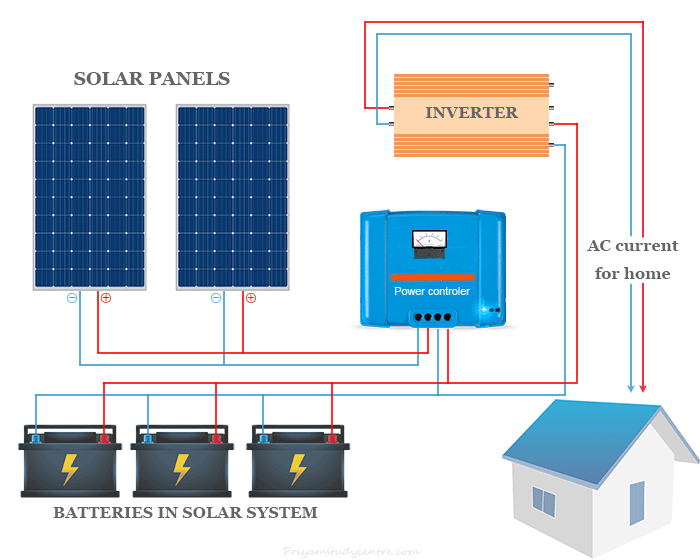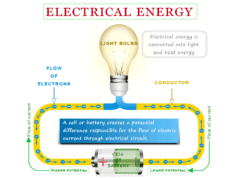Solar Renewable Energy
Solar energy is a renewable energy source that is obtained from radiant light and heat from the Sun and converted into other forms of energy. We use photovoltaic (PV) panels in solar technology for the conversion of solar energy into electricity. Solar panels are used for the production of electricity for both commercial and home use. In both cases, Photovoltaic panels or systems are generally installed on the Roof to get the maximum possible sunlight for the generation of maximum electricity. Green plants convert solar energy into chemically stored energy by photosynthesis. It produces food, wood, and biomass from which fossil fuels are obtained.

Solar Energy Installation Diagram
The step-by-step installation diagram to generate solar energy or solar power is given below the picture,

Install Solar Panels
The first step is to fix the mounts for supporting solar panels in Roof-ground mounts or flush mounts. These can be installed in a place where it gets maximum sunlight.
Electrical Wiring
In solar technology, universal connectors are used during wiring. The panels may be connected by two series,
- Series connection: In a series connection, the positive terminal of one PV module is connected to the negative terminal of another module to increase the voltage that matches the battery used in this installation system.
- Parallel connection: In a parallel connection, the positive terminal is connected to a positive and the negative terminal to a negative to maintain the wiring voltage constant.
Power Controller
In solar systems, a power controller is used to connect solar panels with an inverter and batteries. The charge or power controller regulates the amperage and voltage that is delivered to the loads and any excess power is delivered to the batteries of the solar system.
Inverter and Solar Battery Connection
To connect the solar inverter and the solar battery, the positive terminal of the battery is connected to the positive terminal of the inverter and the negative terminal to the negative. We use solar batteries for backup solar power.
Inverter to a Power Grid Connection
To connect the inverter to the grid, a normal plug is used to connect to the main power switchboard. An output wire is connected with electric boards that use to supply electricity for home appliances.
Starting Solar Inverter
After installation of whole solar energy production systems, start solar inverter to supply electricity for home appliances. The extra electricity can be sold by using a meter.
Solar Technology
Solar technologies are broadly classified into two types, active and passive solar technology depending on the production and distribution of solar energy or conversion of solar power.
- Active solar technology: Active solar technology is used in photovoltaics, concentrated solar power, solar thermal collectors, pumps, and fans for the conversion of sunlight into useful outputs.
- Passive solar technology: Passive solar technology is used in selecting materials with favorable thermal properties, designing spaces that naturally circulate air, and referencing the position of a building to the Sun.
Uses of Solar Energy
Solar energy is a renewable, clean, and affordable form of energy. Solar technologies use mainly to convert sunlight into electrical energy either through photovoltaic (PV) panels or mirrors that concentrate solar electromagnetic radiation. Like other renewable energy, this form of energy can be used to generate electricity or stored in batteries or thermal storage
Solar energy can be used mainly for generating electricity for homes and industries, cooking food, and heating water. There are two types of solar devices such as active and passive devices uses in solar technology.
Solar Energy for Home
Solar power is an environment-friendly and renewable natural resource that does not pollute our environment.
- A solar energy system can be installed in homes for household electricity supply in gadgets used in our homes.
- The panels can be used widely in a solar LED emergency light and a solar charger.
- Solar streetlights can help conserve a lot of electricity used in streetlights.
- Solar-powered cars are already in use in many parts of the world for transportation purposes.
Using Solar Power in Industries
Solar energy can be used in many industries and developmental projects. In industries, a high level of electricity is required due to the use of heavy machinery and equipment. If we use a solar energy system to run such projects, it can save electricity bills.
Solar Energy in Cooking
Solar cooking does not consume any electricity but uses solar thermal energy for cooking food items. The solar oven may use in any place with lots of sunlight. Solar cookers are used for cooking food items and heating water for safe drinking.
Solar Water Heater
The solar water heater is heating water by using sunlight or a solar thermal collector. A variety of models is available at varying costs for different climates and latitudes. There are two types of solar water heating systems, active and passive water heating systems.
Active Solar Water Heater
Active solar water heating systems contain electric pumps, valves, and controllers to circulate water or other heat-transfer fluids through the collectors. It can also be divided into two types,
- Direct circulation system: In active water heating with a direct circulation system, pumps circulate household water through the collectors and into the home. It works well in climates where water rarely freezes.
- Indirect circulation system: Active water heating with an indirect circulation system uses to circulate a non-freezing liquid and heat-transfer fluid through the collectors and a heat exchanger. It works well in climates where water freezes readily.
Passive Solar Water Heater
The passive solar water heater is cheap but not as effective as an active solar water heater system. Passive solar water heating systems generally transfer heat by natural circulation and they do not require pumps to operate. They are the most commonly used for domestic applications.
Advantages and Disadvantages
Advantages of Solar Energy
- It is a clean source of energy that does not cause any environmental hazards or pollution.
- Like fossil fuels, the production of solar energy does emit carbon dioxide that causes air pollution or the greenhouse effect and global warming.
- It is a renewable source of energy and is available on earth as long as the sun exists.
- The energy can be stored in the batteries and used when needed.
- It is a free source of energy that can be trapped easily.
- It reduces electricity bills in your home with very minimum maintenance cost.
Disadvantages of Solar Energy
- The production is low during the winter season and cloudy weather.
- It is an intermittent energy source because, at night, the sun does not shine and solar panels cannot generate power. A simple solution for this is to use a battery storage system installed with your solar panels.
- The initial installation coat is very expensive. Different countries in the world provide subsidies for the installation of solar energy systems.
- A larger space is needed for the installation of solar panels in the production of solar energy.







